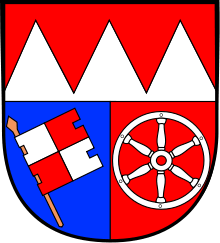Lower Franconia
| Lower Franconia Unterfranken | |
|---|---|
| Regierungsbezirk | |
 Map of Bavaria highlighting the Regierungsbezirk of Lower Franconia | |
| Country | Germany |
| State | Bavaria |
| Region seat | Würzburg |
| Area | |
| • Total | 8,531.59 km2 (3,294.07 sq mi) |
| Population (31 December 2013)[1] | |
| • Total | 1,297,992 |
| • Density | 150/km2 (390/sq mi) |
| Website | regierung.unterfranken.bayern.de |
Lower Franconia (German: Unterfranken) is one of the three administrative regions of Franconia in Bavaria (seven regions), Germany (22 regions in five Federal States, 11 Federal States are not subdivided into regions).
The district was formed in 1817 under the name of Untermainkreis (Lower Main District) and renamed in 1837 as Unterfranken und Aschaffenburg (Lower Franconia and Aschaffenburg). In 1933 the regional Nazi Gauleiter Otto Hellmuth insisted on renaming the district Mainfranken, but after 1945 the name Unterfranken was resurrected.
Unterfranken is the north-west part of Franconia and consists of three district-free cities ("Kreisfreie Städte") and nine country districts ("Landkreise").
The major portion of the Franconian wine region is situated in Lower Franconia.
Coat of arms

The Coat of Arms includes the Arms of Duchy of Franconia in the upper portion, the “Rennfähnlein,” a banner, quarterly argent (silver) and gules (red), on a lance or (gold), in bend, on an azure (blue) field, associated with Würzburg in the lower left quadrant, and a white/silver wheel on a red field symbolizing the clerical state of Mainz, in the lower right quadrant.
Area and population
| City or District | Population (2013) | Area (km²) | Communities | |||
|---|---|---|---|---|---|---|
| City of Aschaffenburg | 67,748 | 5.22% | 62 | 0.7% | 1 | 0.3% |
| City of Schweinfurt | 51,918 | 4.00% | 36 | 0.4% | 1 | 0.3% |
| City of Würzburg | 124,154 | 9,57% | 88 | 1.0% | 1 | 0.3% |
| Aschaffenburg | 172,521 | 13.30% | 699 | 8.2% | 32 | 10.4% |
| Bad Kissingen | 103,003 | 7.94% | 1,137 | 13.3% | 26 | 8.4% |
| Haßberge | 84,136 | 6.49% | 956 | 11.2% | 26 | 8.4% |
| Kitzingen | 88,025 | 6.79% | 684 | 8.0% | 31 | 10.1% |
| Main-Spessart | 126,458 | 9.75% | 1,322 | 15.5% | 40 | 13.0% |
| Miltenberg | 127,980 | 9.87% | 716 | 8.4% | 32 | 10.4% |
| Rhön-Grabfeld | 80,065 | 6.17% | 1,022 | 12.0% | 37 | 12.0% |
| Schweinfurt | 112,916 | 8.71% | 842 | 9.9% | 29 | 9.4% |
| Würzburg | 158,132 | 12.19% | 968 | 11.3% | 52 | 16.9% |
| Total | 1,297,056 | 100.0% | 8,531 | 100.0% | 308 | 100.0% |
| Historical population | |
| 1910 | 710,943 |
| 1939 | 844,732 |
| 1950 | 1,038,930 |
| 1961 | 1,089,983 |
| 1970 | 1,181,309 |
| 1987 | 1,202,711 |
| 2002 | 1,344,300 |
| 2004 | 1,344,629 |
| 2005 | 1,341,481 |
| 2006 | 1,337,876 |
| 2008 | 1,331,500 |
| 2009 | 1,323,273 |
| 2010 | 1,318,695 |
| 2011 | 1,315,882 |
| 2013 | 1,297,056 |
Historical country districts
The municipal reform (Kreisreform) of June 1972 consolidated 22 country districts into nine.
| New district | Former district(s) |
|---|---|
| Aschaffenburg | Aschaffenburg, Alzenau |
| Bad Kissingen | Bad Kissingen, Bad Brückenau, Hammelburg |
| Haßberge | Ebern, Haßfurt, Hofheim in Unterfranken, part of Gerolzhofen |
| Kitzingen | Kitzingen, part of Gerolzhofen |
| Main-Spessart | Gemünden, Karlstadt, Lohr, part of Marktheidenfeld |
| Miltenberg | Miltenberg, Obernburg, part of Marktheidenfeld |
| Rhön-Grabfeld | Bad Neustadt an der Saale, Königshofen, Mellrichstadt |
| Schweinfurt | Schweinfurt, part of Gerolzhofen |
| Würzburg | Würzburg, Ochsenfurt, part of Gerolzhofen, part of Marktheidenfeld |
Well known people
- Florian Geyer
- Tilman Riemenschneider
- Balthasar Neumann
- Friedrich Rückert
- Wilhelm Conrad Röntgen
- Leonhard Frank
- Carl Diem
- Dirk Nowitzki
Institutes of Higher Education
- Julius-Maximilians-Universität Würzburg
- University of Applied Sciences Würzburg-Schweinfurt
- Hochschule Aschaffenburg
See also
References
- ↑ "Fortschreibung des Bevölkerungsstandes". Bayerisches Landesamt für Statistik und Datenverarbeitung (in German). 31 December 2013.
External links
- Official website
- Official website in English
- Official website
- Flag at Flagspot
- Unterfranken 1910
- Statistics
- Lower Franconia, described by a native franc resident
| ||||||||||||||